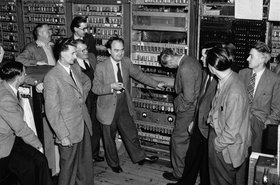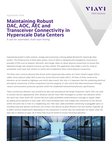Software-defined WANs are a great technology and Robert Sturt, Managing Director of Netify, argues that they’re “the most fundamental change in networking since MPLS took over from frame relay and asynchronous transfer mode.” He believes SD-WANs are the beginning of the technology stack journey and their integration with artificial intelligence and automation represents the “next phase of capitalising on extensive insights and data already generated by SD-WAN systems." [TechTarget] An example is the use of cloud AI with SD-WANs to reduce false positives frp, an intrusion protection system.
That might be the case, however. it’s worth noting that software-defined products are not new. I worked on CPU boards in the 80s using bit-sliced processors with finite state machines, before the time that microprocessors became powerful enough to be used seriously in mini-computers. If my team wanted to emulate a DG Nova, we fitted one program, and if we wanted to emulate a PDP11, we loaded different software.
What changed the market from dedicated ASICs to microprocessors was a combination of Linux and the generation of microprocessors that could handle the memory and I/O throughput required for products, such as SD-LAN switches, SD storage and now SD-WANs. In fact, all Bridgeworks’ bridging and data acceleration products have been software-defined since 2004.
SD-WANs: Massive potential
I have to admit I am a great fan of SD-WANs. The potential for these products is massive. However, there is a need to get the basics right, and the biggest issue is performance. More and more data is moving across ever greater distances, over ever-increasing bandwidths and, so, if SD-WAN is going to make it, the industry has got to move up the performance ladder. Will adding bells and whistles make a difference to performance? Unlikely, at least they’re not going to help in the long-term.
AI and AIOp are a key focus for many vendors. However, as has been seen in other AI implementations, a great deal of thought has to go into it. This involves having to think differently.
Sturt comments:
“According to Gartner, automation will operate more than 70 percent of network tasks, such as adds, moves and changes. This means faster delivery with fewer outages and reduced WAN issues. AI for IT operations (AIOps) and DevOps will have the ability to make changes on a 24x7 basis.”
Vendors and analysts often talk about how AIOps will revolutionize the use of SD-WANs and automate so many functions, based on data and patterns. They also say they allow organizations to create policies for different types of data. Yet, in my view, if they are going to use AI, they should let the technology create the data policies.
Accelerate critical data
AI should also be used to identify data usage patterns and to accelerate critical data, and it should not be used to slow everything down. There are WAN Optimization and Data Acceleration tools available that can make a real difference to data transfers over the WAN (and it should be noted that WAN Optimization often fails to live up to its promise).
Furthermore, after more than 70 years since the introduction of the first commercial computer , it’s about time AI was implemented to self-configure and self-manage products that organizations can install and forget. AI should not be for marketing another Gartner AIOps fad. AI must be used to empower and remove human burden to improve data, task and network quality, efficiency and performance.
So, is automation the next phase of capitalising on extensive insights and data “already generated by SD-WAN systems?” At the moment, there are two methods of improving the throughput of data over the WAN:
- WAN Optimization, which is really data optimization, as it uses deduplication to reduce the amount of data transferred. Itis great technology for files data that has repeated characters, such as with Microsoft Word files.
- WAN Acceleration uses parallelization of the data into many streams controlled by AI. In this instance, the AI self-manages and self-configures, so it requires no supervision. Organizations can install it and forget it. The advantage WAN Acceleration has over WAN Optimization is that it does not care about the format of the data. It treats all data the same and so it can accelerate data that has already been encrypted. WAN Acceleration can be built into the higher SD- WAN products, as an overlay, to support 5Gb/s and above WAN bandwidth; or it can sit between the SD-WAN and the WAN.
Improving WAN performance
For organizations wanting to significantly improve the performance of their WAN and SD-WANs, they would benefit from deploying selective IP ports WAN Acceleration. Its use of data parallelization increases throughput over the WAN. To maximize the use of the WAN Acceleration, it is important to maintain the maximum data flow into the WAN Acceleration device. This is in contrast with WAN Optimization, which tries to optimize the data across all IP ports.
With regards to SD-WANs, organizations should allow the AI in the SD-WAN to select the traffic to accelerate. SD-WAN and WAN Acceleration are made for each other. By having them on the same WAN, this can maximize the throughput over the WAN and the beauty of WAN Acceleration is that it is transparent to the SD-WAN.
Where there are requirements to send bulk encrypted or compressed data such as video, it’s important to route these to the WAN Acceleration device. Yet, because of the performance of WAN ACC, it’s vital to ensure they choose a SD-WAN package or device that matches or exceeds the bandwidth capability of the WAN Acceleration. Where bandwidth management is required during the day or night, organizations can make use of the throttling capabilities in WAN Acceleration to maximize the throughput, without disrupting the other traffic.
Preventing data loss
Consultants are now preaching the benefits of 3-2-1 backup polices to prevent data loss: three copies of the same data, two copies on different media and one copy offsite. But what if everything goes wrong and the offsite copy is needed? What if the Cloud provider is also down, what then? With WAN Acceleration, it’s so easy to have a further remote copy thousands of miles away without the penalties in performance caused by latency and packet loss.
My philosophy is to never get down to a choice of one if it can be easily avoided, and WAN Acceleration gives you 3-2-2 with very little increase in complexity and cost. While WAN Acceleration gives organizations the freedom to negate latency and packet loss, it remains vital to air gap offsite backups as the cyber-attacks are now focusing on the backup software and files first to prevent recovery from backups. Without that air gap, you may never recover. So, organizations can undoubtedly benefit from WAN Acceleration, but when it comes to cyber-security, other strategies should be executed, too.





